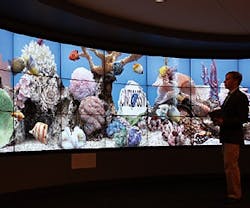A video wall that’s big or small, short or tall, curved or flat – and just plain interesting to look at – can create a larger-than-life centerpiece to draw the eye and intrigue the mind.
The rapidly evolving technology, a series of individual screens connected by super-slim spacers (or "bezels"), offers a more cost-effective alternative to mounting a single huge screen for information or decoration. Many video walls allow you to add more screens later as your budget permits, as long as they match your original screen choice.
"It’s more economical to take several smaller screens and put them together like Lego blocks to build a wall," says Ryan Cahoy, managing director of video wall manufacturer Rise Display. "Buying a 100-inch plasma screen is very expensive."
Create an Experience
Start the search by deciding what you’ll need your video wall to accomplish. Do you want a passive system to display information or an active system that people can interact with? Video walls can complement the visual experience in many applications:
-
Education: Create a digital bulletin board in a common area for announcements or post a larger display space in classrooms.
-
Banking: Entertain waiting customers and cross-market financial products.
-
Call centers and trading floors: Track internal metrics or scores in real-time.
-
Airports and transit centers: Update arrivals, departures, delays, and cancellations as they happen.
-
Healthcare: Honor donors with an easily expandable database, unlike an etched glass wall that will eventually run out of room.
-
Retail: Spotlight new inventory, announce sales and discounts, or post QR codes that pull up text, photos, videos, or websites.
-
Office: Offer a single shared canvas for collaboration.
Your specific needs will also dictate the size, location, and complexity of the wall. A classroom could use a small wall and post different information on each screen because students would be looking at it from just a few feet away. An airport or a financial trading floor, however, would need a large wall with one big display so it can be seen from a long distance.
You’ll also need to define your priorities. Which do you need more: thin bezels or a thin display? Both are continually shrinking, Cahoy says, but thin bezels frequently require more depth. Don’t neglect the software controlling the wall, either – with this eye-drawing device, content is king.
"You could have the most expensive and thinnest hardware, but if you put TV or a simple PowerPoint up, you don’t get the full impact of the technology," Cahoy says. "It’s like buying a car and putting a cheap engine in it."
Watch the Road Ahead
The key to maximizing your video wall’s usefulness is to look to the future. Maintenance is minor – shutting them off overnight allows the machinery to cool down and avoid image retention, similar to a TV or computer, and cleaning the fans every 6 months prevents overheating. You can expect the device to last 6-8 years, so you’ll need to give some serious thought to how you’ll want the space to look in a few years.
"As your needs evolve, we can continuously update content and types of content," says Robert Kaufman, a founding partner of Cinemassive Displays. "A very simple, basic project might start off using PowerPoint, but from there you can go to full immersive 3-D touch capability."
Besides building extra screens into the display, imagine how you’ll want it to grow functionally. Today, you may post QR codes that send customers to your website whenever they scan the code with their smartphones. Tomorrow, you might want to engage them in a more hands-on way.
"We can build proximity sensors into the video walls that trigger specific events when an audience is close to it," Kaufman says. "Once there’s someone who’s interested in the sign, we can change the content to engage that person. The realm of user participation is the future." B
Janelle Penny ([email protected]) is associate editor of BUILDINGS.
About the Author
Janelle Penny
Editor-in-Chief at BUILDINGS
Janelle Penny has been with BUILDINGS since 2010. She is a two-time FOLIO: Eddie award winner who aims to deliver practical, actionable content for building owners and facilities professionals.

